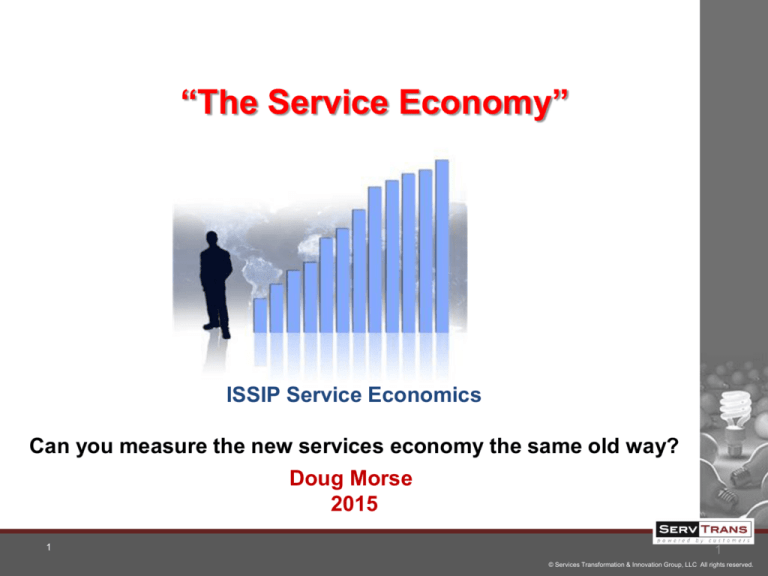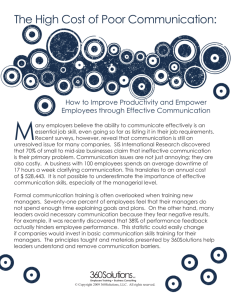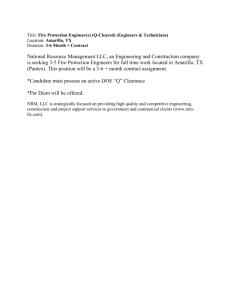
“The Service Economy”
ISSIP Service Economics
Can you measure the new services economy the same old way?
Doug Morse
2015
1
1
© Services Transformation & Innovation Group, LLC All rights reserved.
Service Economics Group Charter / Mission
The key purpose Service Economics Group is to bring together a diverse team of individuals and organizations
to help define and better understand current and desired future state economic tools, models, processes and
technologies that would reduce inhibitors to current service innovation and to drive change that accelerate
service innovation in the future. Ultimately the group would become an instigator / influencer of change to
economic policies, economic and business metrics and accounting rules in support of the services economy.
This may include but is not limited to the following:
Create a center of knowledge and expertise around service economics
Use the COE ( Center of Expertise ) to drive change that promotes service innovation, new education
models, public policy and economic models.
Understand new forms of value creation
o Customer Equity – Customers as an asset – beyond ‘goodwill’
o Value of Data (big data, sensor data et al.)
o Touchpoint value ( Twitter, Facebook, other social media that collects visits and views )
Research and education of both micro and macro-economic models of service(s)
Definition and valuations of non-tangible economic transactions
Create and disseminate intellectual property (papers, books, presentations etc.) that create a better
understanding of services related economics
1
© Services Transformation & Innovation Group, LLC All rights reserved.
% GDP from Service
Country Name
2008
2009
2010
2011
2012
2013
United Kingdom
77.2
78.5
78.7
78.4
78.9
79.2
France
77.6
78.5
78.6
78.3
78.2
78.5
North America
76.5
78.3
77.9
77.8
77.7
United States
77.2
78.8
78.4
77.8
77.7
Italy
71.8
73.8
73.7
73.7
74.2
OECD members
73.0
74.7
74.1
74.0
74.2
European Union
72.4
74.1
73.7
73.6
73.9
74.1
Euro area
72.1
73.8
73.4
73.3
73.5
73.7
Singapore
72.6
72.1
72.3
73.6
73.3
74.9
Japan
71.3
72.8
71.3
72.7
73.2
Europe & Central Asia (all income levels)
71.0
72.8
72.3
72.0
72.4
World
68.9
70.6
70.0
69.7
70.1
Australia
69.7
68.6
70.6
69.1
69.3
70.7
Germany
69.2
71.6
69.3
68.7
68.4
68.4
Latin America & Caribbean (developing only)
61.0
63.1
62.0
62.8
63.3
64.2
Central Europe and the Baltics
62.7
63.7
63.3
61.9
62.4
62.4
Latin America & Caribbean (all income levels)
59.7
61.6
60.4
61.1
61.7
62.5
Korea, Rep.
61.2
60.7
59.3
59.1
59.5
59.1
Sub-Saharan Africa (all income levels)
50.0
52.2
55.8
55.4
55.9
57.3
China
41.8
43.4
43.2
43.4
44.6
46.1
45.2
41.6
42.3
42.9
Middle East & North Africa (all income levels)
1
74.4
72.7
Source World Bank : http://data.worldbank.org/indicator/NV.SRV.TETC.ZS/countries
© Services Transformation & Innovation Group, LLC All rights reserved.
A Few Interesting Questions
How do we measure the services economy ?
Is Service Revenue double counted?
Are NAICS / SIC Codes and other classification systems are outdated?
Why do Businesses have to reach financial doom before expanding Services?
Do FASB Reporting and Revenue Recognition rules inhibit servitization?
What economic factors drive Services R&D? (private or public )
What economic factors affect national and international policies regarding Service?
How do labor laws affect the growth of services in world trade?
How do economic measures drive education?
Are Consumption Economics and Service Economics Related?
Are Services best measured as a 3rd Generation of the Industrial Revolution?
Can Customer Equity become a new measure to value companies?
What is the value of Data or core knowledge workers?
1
© Services Transformation & Innovation Group, LLC All rights reserved.
Why NAICS / SIC codes matter
For more info: http://www.census.gov/eos/www/naics/
1
© Services Transformation & Innovation Group, LLC All rights reserved.
Projected US Service Employment Growth, 2008 - 2018
Service-providing
industries are projected
to account for the most
job growth between
2008 and 2018.
In goods-producing
industries,
employment is projected
to stay about
the same over the
decade.
This is due, in
part, to increased
demand
for services and
the difficulty of
automating
service tasks.
US Bureau of Labor Statistics.
http://www.bls.gov/opub/ooq/2008/winter/art03.pdf
1
ServTrans LLC –All rights reserved
© Services Transformation & Innovation Group, LLC All rights reserved.
How many jobs were created or changed by new Services?
1
ServTrans LLC –All rights reserved
© Services Transformation & Innovation Group, LLC All rights reserved.
Manual labor to cognitive thinking
1
© Services Transformation & Innovation Group, LLC All rights reserved.
Global Economic Shifts
Ag Economy
1
Industrial Economy
ServTrans LLC –All rights reserved
Service Economy
© Services Transformation & Innovation Group, LLC All rights reserved.
Agricultural sector
Agriculture (a term which encompasses farming) is the process of
producing food, feed, fiber and other goods by the systematic raising of
plants and animals. Agricultural output is a component of the GDP of a
nation.
Industrial sector
Industry is the segment of economy concerned with production of goods
(including fuels and fertilizers). Industrial output is a component of the
GDP of a nation. It includes mining and extraction sectors.
Service sector
A service is the non-material equivalent of a good. Service provision is
defined as an economic activity that does not result in ownership, and
this is what differentiates it from providing physical goods. It is claimed
to be a process that creates benefits by facilitating either a change in
customers, a change in their physical possessions, or a change in their
intangible assets. Service output is a component of the GDP of a nation.
The service sector includes farm and factory related activities
1
ServTrans LLC –All rights reserved
© Services Transformation & Innovation Group, LLC All rights reserved.
From Transaction to Value Exchange – definitions of service(s)
Service (s)
The application of skills and knowledge (operant resources) for the benefit of another
party . (Vargo and Lusch 2004a; 2006), Service Dominant Logic
Or
Service is any transaction of economic value that can not be dropped on your foot.
“The Economist “ -2006
Service System
Complexity
Service has a greater focus on the management of knowledge as an asset and the channels
through which knowledge, information and signals flow.
Therefore, a Service System is a dynamic configuration of value co-creating resources that
includes people, organizations, shared information, and technology connected holistically
and organized to create new value outcomes by optimizing the creation and use of skills and
knowledge for the benefit of others
Service Value Network
A (service ) value network is a web of relationships that generates economic value and
other benefits through complex dynamic exchanges between two or more individuals,
groups, or organizations. Any organization or group of organizations engaged in
both tangible and intangible exchanges can be viewed as a (service) value network,
whether private industry, government, or public sector.
Interpreted from: Verna Allee from ValueNetworks.com™
1
ServTrans LLC –All rights reserved
© Services Transformation & Innovation Group, LLC All rights reserved.
Economic Drivers of Business
Powered by Labor
Powered by Machines
Powered by Technology
Powered by Information
Powered by Customers
1
…Consumption Driven
© Services Transformation & Innovation Group, LLC All rights reserved.
Business Innovation Shift
Product Centric
1
Customer Centric
Outputs
Become
Outcomes
Products
Evolve into
Solutions
Transactions
Develop into
Relationships
Suppliers
Link up into
Partner
Networks
Elements
Interconnect
to become
Eco-systems
ServTrans LLC –All rights reserved
© Services Transformation & Innovation Group, LLC All rights reserved.
Relationship Creates Value
Interaction
Transaction
$$$
$
Browse
Commodity
Search
Serve
Packaged
Service
Experience
$$$$$
Relationship
Experience
Source: BusinessWeek 2005
1
ServTrans LLC –All rights reserved
© Services Transformation & Innovation Group, LLC All rights reserved.
Burning Platform (s)
• Economic value principles are still deeply rooted in the
Industrial economy and from work dating back to the late
1700’s by Adam Smith in his book, “The Wealth of Nations
• Wealth is created by efficient creation of tangible assets
• Money is a core driver of change and measurement of
success so economic understanding is required
• Servitization and Service Innovation are inhibited by
antiquated economic measurement and classifications
• We try to measure the intangible translated into tangible
terms
• Knowledge as an ASSET
• Customer Goodwill (loyalty) as an ASSET
• How do you measure the value of an OUTCOME?
1
© Services Transformation & Innovation Group, LLC All rights reserved.
Why Change ?
Business Success and Valuations
• Servitization – move from goods to services
• Consumption economics is different than production
economics
• Revenue Recognition
• Income to expense ratios reverse in consumption
models - models become back loaded
• Business Valuations
• Value of customers
• Value of “eye balls” ( target marketing )
• Value of data ownership
• Changes in Brand Value
• Value Chain (Networks) vs. Supply Chain
• Who is the customer?
1
© Services Transformation & Innovation Group, LLC All rights reserved.
Why Change ?
Business Metrics and KPI’s
• Return on:
• Capital, Investment, Assets
• What is the new ‘leverage’ metric?
• Bookings v.s Sales – Forecast models
• Software License vs. Subscription
• SaaS / PaaS / IaaS
• View to sales conversion rates
• Customer Equity
• Lifetime Value of Customers
• Experience Value
1
© Services Transformation & Innovation Group, LLC All rights reserved.
Can We Define Simple Economic Models
Industry Needs
National Interests
Natural or
Unnatural Events
Demand
Research and Funding $$$
Economic Drivers
Alumni
$$$
Innovation
Advancement
of Knowledge
Universities
Public
Policy
Influence
IP and New
Businesses
High Skilled Labor
Supply
18
U.S. trade in commercial knowledgeintensive services and intangible assets—
business, financial, and communications
services, and payments of royalties and
fees—has produced a consistent and
growing surplus (figure O-38). It reached
a record $108 billion in 2008, sufficient to
counter-balance the high-technology
goods deficit, and has been flat since
then, reflecting the recession's effect. The
EU's surplus was sharply off, and that of
the Asia-8 fell as well—reflections of the
continuing effects of the global recession.
NSF Science and Engineering Indicators 2012
19
Some Informational Links
How Do We Measure the Services Economy ?
Service as Percent of GDP
http://wdi.worldbank.org/table/4.2
http://data.worldbank.org/indicator/NV.SRV.TETC.ZS/countries
U.S. Bureau of Economic Analysis ( BEA )
http://www.bea.gov/itable/index.cfm
NAICS / SIC Codes and Other Classification Systems are outdated
http://www.census.gov/eos/www/naics/
Are Consumption Economics and Service Economic Related?
http://www.tsia.com/research/books-by-tsia/consumption-economics.html
Nation Master Data
http://www.nationmaster.com/country-info/stats/Economy/GDP
Are Services best measured as a 3rd Generation of the Industrial Revolution?
http://www.theguardian.com/sustainable-business/jeremy-rivkin-third-industrial-revolution
20
Discussion?
1
© Services Transformation & Innovation Group, LLC All rights reserved.
U.S. services driving overall exports growth, topping half a trillion
dollars
The U.S. Department of Commerce’s Economics and Statistics Administration (ESA) released
a report showing U.S. trade in private services totaled $526.6 billion in 2010, representing a
trade surplus that is growing, rising from $66.7 billion in 2003 to $168 billion in 2010.
By country, the largest U.S. surpluses in services are with Canada, Japan, Ireland, Brazil,
the United Kingdom, China and Mexico. The U.S. services surplus with China has
accelerated rapidly since 2007, from $2.4 billion to $10.4 billion in 2010, because of sharp
gains in exports and relatively flat imports, according to ESA data.
Exports support more than 10 million American jobs, and those whose jobs depend on
trade earn 13 to 18 percent more than the national average. As a result of administration
policies and the global economic rebound, exports grew 17 percent in 2010 compared to
2009 – the largest year-to-year percent change in more than 20 years.
Private services are defined as non-tangible items of value that are either consumed
when purchased or at a later date by their terms of sale, such as school tuition or an
airplane ticket. These are distinct from tangible items, or “goods,” such as oranges or
motor vehicles.
22
U.S. Surplus with China is Growing Rapidly Figure 4: Trade Balance in Private Services Billions of dollars
1992 1995 1998 2001 2004 2007 2010 -40 -200 20 40 60 80 100 -40 -20 020 40 60 80 100 Royalties and
license fees Travel and fares Freight and port use Other private services Source: Bureau of Economic
Analysis. Figure 5: Largest U.S. Surpluses and Deficits by Country in 2010* Private services trade, billions
of dollars Canada Japan Ireland (2009) Brazil United Kingdom China Mexico India Bermuda (2009) -30 -20
-10 0 10 20 30 Source: Bureau of Economic Analysis. * 2009 data is used if 2010 is not available.
23
24

![Your_Solutions_LLC_-_New_Business3[1]](http://s2.studylib.net/store/data/005544494_1-444a738d95c4d66d28ef7ef4e25c86f0-300x300.png)


